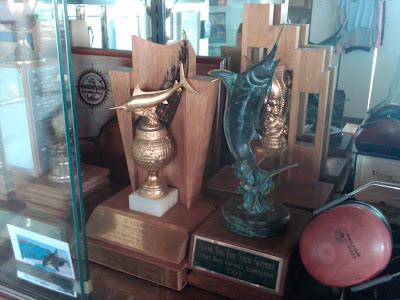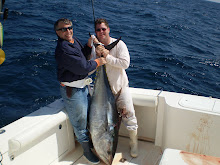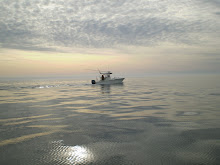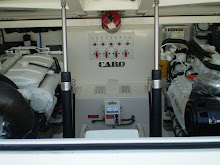Station 41025 (LLNR 640) - Diamond Shoals
35.006 N 75.402 W (35°0'22" N 75°24'7" W) By Jim Field
By Jim FieldAs weekend sportfishermen (that's us!) we live and die by weather conditions that happen to develop--by pure chance, of course--for the weekend: 2 days out of 7, or 28.6% of daily fishing opportunities in a week. Given this highly circumscribed time frame, imposed upon us by the twin commitments of work and family--and, why not go to the beginning, to the unfortunate fact that none of the Crew is the deserving beneficiary of inherited wealth--it's often the case that we get screwed, royally screwed. Why is this the case?
Well, for starters, weather is unpredictable--I mean, it sets the benchmark on uncertainty. If (1) you can only fish on certain days of the week, and (2) these designated days make up just over a quarter of days in a year, and (3) good weather develops randomly, and (4) is a subset of potential weather patterns, and (5) you can only fish in good weather, then walla--do the math!!!!--you're not going to end up on the water very often! (Meaning, you're getting screwed.)

And then there's a second form of "getting screwed" to consider. The process goes like this: in arranging a fishing weekend, we spend valuable spousal capital to get a "free pass" for an upcoming weekend. (These chits, I'll note, are difficult to secure.) Then the weekend rolls around and the weather is, let's say, terrible. So, you don't go fishing, and you don't use the free pass, but--and here's the catch!--
you are unable to hand it back at face value. Oh nooooo! Because you asked for the pass, and received it, and the weekend agreement was in fact consummated, you wind up using some of the free pass' goodwill. So, next time around, getting a free pass will be even more difficult--because in not going fishing, you nevertheless had reserved and been bestowed time to fish, and so you used 20% of the pass, which is applied by one's spouse as a weighting factor in determining the odds of fishing in the future. Now that, in my book, is also getting royally screwed, part II.
In our group commiserations, about the punitive nature of imposed marital scheduling practices, and in particular, the cruel fates of fishing weather, we have noted, however, our impression that weather patterns this last fall have been particularly unkind to us, the weekend sportfishermen. Not that we're developing a persecution complex, or anything, but it is beginning to get us down. Now, we don't have data on this, but it seems as though at least 50%, maybe as high as 60%, of absolute weekends have been purse washouts, with even higher percentages applicable to weekends we explicitly reserved for an outing.
Alas, upon awakening this morning, and checking out the weather, and finding it, predictably, just horrible (insert primordial yell: Ahhhhhhhhhhhh!), I'm thinking that we should bring some science to this whole issue. Instead of guessing the record on weather, perhaps if we had hard data, we could turn this in our favor. Specifically, if we could quantify our bad luck, perhaps this would create some spousal empathy for our plight, and we could use this to (1) secure fishing weekends more easily and with enhanced flexibility built in, and (2) help restore full value of our returned free passes.
So, from this day forth this blog will track weather at Diamond Shoals buoy for each weekend across the year (we can also do this for the Delaware light ship buoy). This new blog feature can be found in the right-hand column, at the very bottom, the last box of test. The data collected and shown will be presented as follows, using this weekend as an example:
February 27-28Reserved: No
Sat--WDIR WNW, WSPD 31.3 kts, WVHT 12.8 ft
Sun--
Verdict:
UnfishablePersonally, this will be fascinating to track. I mean, what other Crew has this kind of data on hand? It could really make science work for the betterment of mankind (i.e., us). I'm certainly going to make sure that my "loving spousal unit" (LSU) is kept appraised of the latest aggregated numbers.


























































